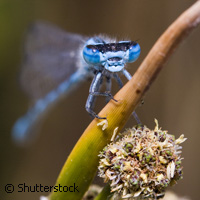How damselflies learn to choose best mate
Damselflies learn how to choose the right mate when two species co-exist locally, according to researchers from Lund University in Sweden, who found that a female will throw away her eggs if she mates with a male of the wrong species because mating outside her own species will reduce the number of offspring. So the choice of mate is not just a matter of genetic and instinctive behaviour, as has often been assumed for such small and short-lived creatures. The research was recently published in the scientific journal Evolution. Professor Erik Svensson from the university's Department of Biology and his colleagues studied two co-existing species of damselfly, called 'demoiselles' and belonging to the genus Calopteryx. Both damselflies and the more well-known dragonflies belong to a group of insects called odonates. The researchers investigated how females choose males with whom to mate, and found that they keep a close eye on the appearance of their mate. The main difference between the two species in terms of appearance is the amount of black on the males' wings. 'It is fascinating to see that even small insects can learn these things,' Professor Svensson said. The researchers studied the mating behaviour of the damselflies at several different locations in southern Sweden. At some of the sites, the two species live alongside one another and here the females rejected the males of the other species. However, at other sites, only one of the species is present, and the females subsequently showed much greater interest in males of the other species when they were presented to each other in a field experiment. The females at these sites were clearly not aware that these novel males were the wrong species when they came into contact with them for the first time, according to the scientists. 'It is interesting that the females at the different sites behave very differently, despite the fact that the different sites are not far from one another,' Professor Svensson pointed out. According to him, if the choice of mate was only a genetic or inherited behaviour, the differences between the sites should not be as dramatic, because the dispersal of individuals and the resulting gene flow between sites should erase such strong differences in mating behaviour. The researchers carried out additional field experiments to investigate whether young and sexually inexperienced females learnt to recognise males of their own species. Newly hatched and sexually inexperienced female damselflies were captured in the field and kept isolated in cages without any contact with males. When these virgin females then encountered the males of both species for the first time, they showed equal interest in the males of both species. In another experiment, newly hatched females were again kept isolated in cages, but were able to see males of their own species for a while, yet without physical contact. When these females were subsequently exposed to physical contact with the males, they developed a stronger interest in their own species and showed a reduced interest in males of the other species. 'Our experiments clearly show that the choice of mate is learnt and not merely genetic,' concluded Professor Svensson. However, he admitted that his team was yet unsure about 'the learning mechanisms or exactly what happens during the short learning time of just a few hours'. He said he was 'planning further experiments in the future to investigate these mechanisms'.
Countries
Sweden



